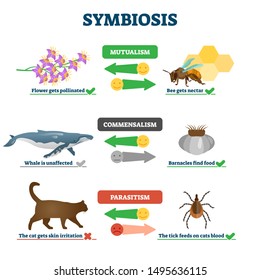Explain How Parasitism Differs From Commensalism.
In Commensalism two different species interact with out other and the commensal alone gets benefits without harming the host. Commensalism mutualism and parasitism are the three main categories of symbiosis found in nature.
Predation Mutualism Commensalism Or Parasitism
The relationship of mutualism is obligatory commensalism is obligatory while that of parasitism is either obligatory or facultative Mutualism is a symbiotic relationship where both species benefits commensalism is where one species benefits more than the other whereas parasitism is where one species benefits while the other gets harm.

. Explain how parasitism differs from commensalism. Parasitism is a relationship of two organisms wherein one organism benefit from the other with harm done. Parasitism and commensalism both benefit one organism but in parasitism the second organism is affected while in commensalism it is not.
However the other entity is neither harmed nor benefited. Parasitism is an interaction in which one of those species would benefit at the expense of the host organism. Parasitism is an interaction in which one party is benefited at the expense of the other party.
In Mutualism two different species interact and take mutual benefits for a long or short period of time. 7 What is an example of mutualism. Finally there is Commensalism which is one of the harder types of interactions.
Thus in commensalism we have one positive and one neutral result while in parasitism we have one positive and. 9 What are 5 examples of mutualism. Fleas and intestinal worms get food and a nice place to livr while the dogs and the livestock are being leeched off of and malnourished.
This interaction is when two species interact and only one of them benefits. Parasitism is the relationship where only one organism receive benefits while the other is. 4 How are mutualism and parasitism different group of answer choices.
8 How is parasitism different from commensalism quizlet. Commensalism is the non-obligatory relationship where one organism of the two different species gains benefits while other is unaffected. How parasitism different from commensalism quizlet.
It is beneficial for plants to have their seeds dispersed to reduce competition. Explain how parasitism differs from commensalism. So to review mutualism is where both organisms benefit commensalism is where one benefits and the other is unaffected and parasitism is.
Parasitism is when one organism benefits at the cost of its host. Sets with similar terms. Parasitism is a symbiotic relationship in which one species the host is harmed while another species the parasite benefits.
Monarch Butterfly and Milkweed. Examples of parasitism are Phronima and Salps a type of zooplanyton. Often the commensal relation is seen between a large host and a small.
Commensalism In a commensal relationship one species benefits and there is a neutral effect on the otherit neither benefits nor is harmed. Parasitism and commensalism both benefit one organism but in parasitism the second organism is affected while in commensalism it is not. The Phronima is a parasite and the Salps are the hosts.
Commensalism is when one organism benefits while the host is left unharmed- but also doesnt really get. Commensalism is when two species interact and one benefits but the other organism is neither harmed nor benefited. 6 What do mutualism commensalism and parasitism have in common.
Commensalism is a symbiotic relationship among organisms in which only one species get benefits while the other species remain unaffected. From commensalismFAQexplain how parasitism differs from commensalismadminSend emailNovember 30 2021 minutes read You are watching explain how parasitism differs from commensalism. Like fleas on a dog or intestinal parasites to livestock.
10 What is parasitism in. The key difference between commensalism and parasitism is that in communalism one party is benefitted whereas in parasitism one party is harmed completely or partially. 5 What is the difference between mutualism and competition.
Commensalism is a relationship of two organisms wherein one organism benefit from the other with neither harm nor benefit to the other. The commensal can obtain shelter nutrients locomotion and support from the host species that is unaffected substantially.
Symbiosis Definition Types Expii
Symbiotic Relationships Mutualism Commensalism And Parasitism Ck 12 Foundation
Commensalism Images Stock Photos Vectors Shutterstock
Benefit Without Harm Commensalism Explained Commensalism Commensalism Relationship Symbiotic Relationships
12 5 What Are Symbiotic Relationships
Symbiosis In The Marine Environment Symbiosis In The Underwater World Symbiosis Marine Environment Underwater World
Symbiosis Mutualism Commensalism And Parasitism Biology Classroom Teaching Biology Science Biology
Difference Between Commensalism And Parasitism Compare The Difference Between Similar Terms
Mutualism Commensalism Parasitism Types Of Symbiosis With Examples Science Trends
Symbiosis Notes And Want Ad Project Distance Learning Digital Lesson Symbiosis Wanted Ads Mutualism
Relationships The Bay The Ecology Of The Chesapeake Bay
Whale Shark Dive The Big 5 Whale Shark Whale Whale Shark Diving
Animal Symbiosis Lesson Bundle Students Learn About Parasitism Mutualism And Commensalism Amazing Visuals Video And Symbiosis Teaching Biology Mutualism
Interactions Between Populations Video Khan Academy
Commensalism Interaction Definition Types And Examples
Symbiosis Parasitism Mutualism Commensalism Jigsaw Frayer Model Answers Commensalism Mutualism Dna Activities
5 Difference Between Mutualism Commensalism And Parasitism With Table Core Differences
Comments
Post a Comment